In the vast landscapes of Texas, a diverse avian tapestry is painted by 16 distinct woodpecker species.
These remarkable birds, characterized by their unique markings, behaviours, and ecological roles, contribute to the state’s rich biodiversity.
Each species encapsulates a fascinating chapter in Texas’ natural history, from the vibrant Red-headed Woodpecker to the elusive Ivory-billed.
This compilation delves into the intricacies of these woodpeckers, exploring their sizes, habitats, and their critical roles in ecosystems.
As we embark on this journey through the woodlands and urban areas of Texas, we uncover the fascinating lives of these feathered percussionists, underscoring their significance in the ecological harmony of the Lone Star State. Thank you so much.
16 Woodpeckers of Texas
Explore the diverse world of woodpeckers, each with unique characteristics and habitats.
From the striking Red-naped Sapsucker to the elusive Ivory-billed Woodpecker, discover the intriguing lifestyles of these birds, contributing to the rich avian tapestry across North America.
1. Red-headed Woodpecker
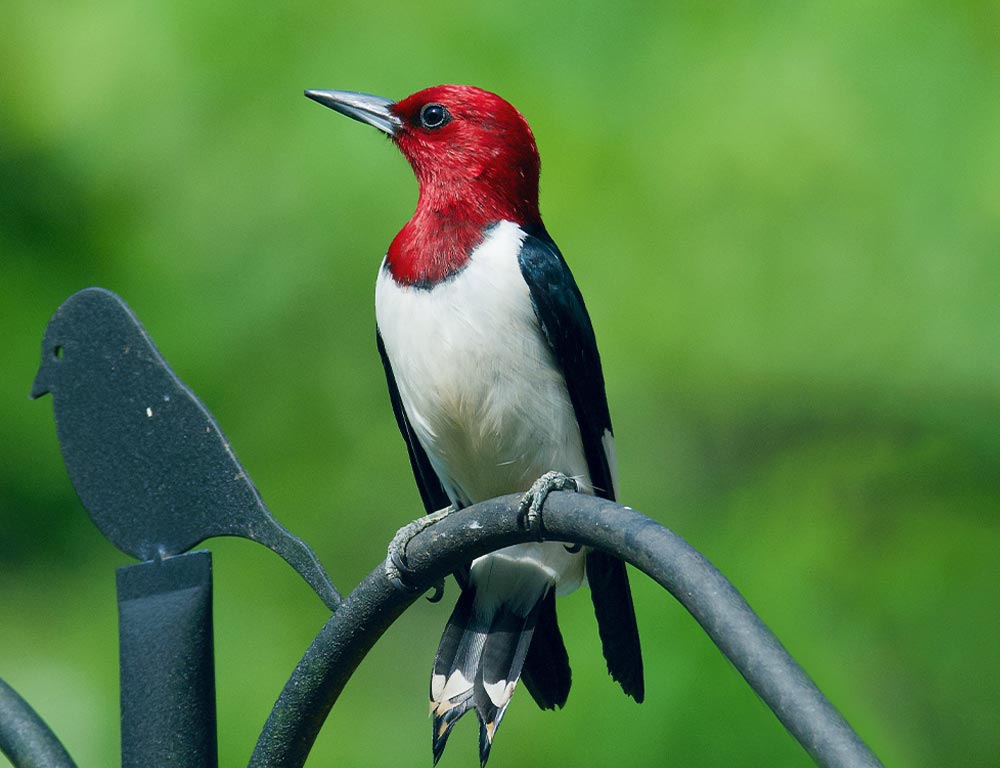
- Scientific name: Melanerpes erythrocephalus
- Size: 7.5 to 9.8 inches
- Weight: 2.2 to 3.2 ounces
- Food: Insects, seeds, fruits, and occasionally small vertebrates
- Population: Declining, considered near-threatened
- Life span: Up to 9 years
- Wingspan: 16.5 to 17.7 inches
- Status: Near Threatened
The Red-headed Woodpecker is easily recognizable by its vibrant redhead, black and white body, and distinctively large wingspan. This species is known for its acrobatic flight and striking appearance.
Red-headed Woodpeckers are versatile foragers, utilizing their strong bills to catch insects and their caching behaviour to store surplus food.
They inhabit a variety of environments, from woodlands to open country. Unfortunately, their populations have decreased due to habitat loss and competition for nesting sites.
Conservation efforts are underway to protect and restore suitable habitats for this iconic woodpecker.
2. Pileated Woodpecker
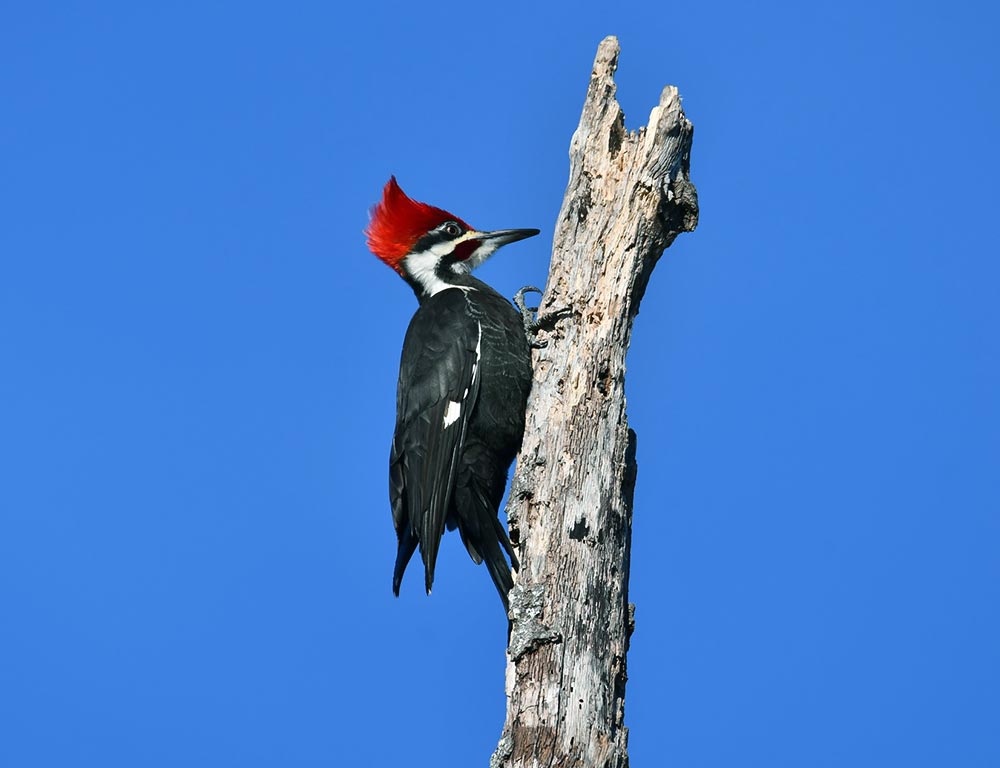
- Scientific name: Dryocopus pileatus
- Size: 16 to 19 inches
- Weight: 8 to 12 ounces
- Food: Insects, fruits, and nuts
- Population: Stable
- Life span: Up to 15 years
- Wingspan: 26 to 30 inches
- Status: Least Concern
The Pileated Woodpecker is one of the largest woodpeckers in North America, characterized by its striking black and white plumage and prominent red crest.
These birds are skilled foragers, using their powerful bills to extract insects from tree bark and create large, rectangular holes in search of carpenter ants.
Pileated Woodpeckers prefer mature forests but can also be found in suburban areas with suitable habitat. Their populations are relatively stable, benefitting from conservation measures and adaptable behaviour.
3. Downy Woodpecker
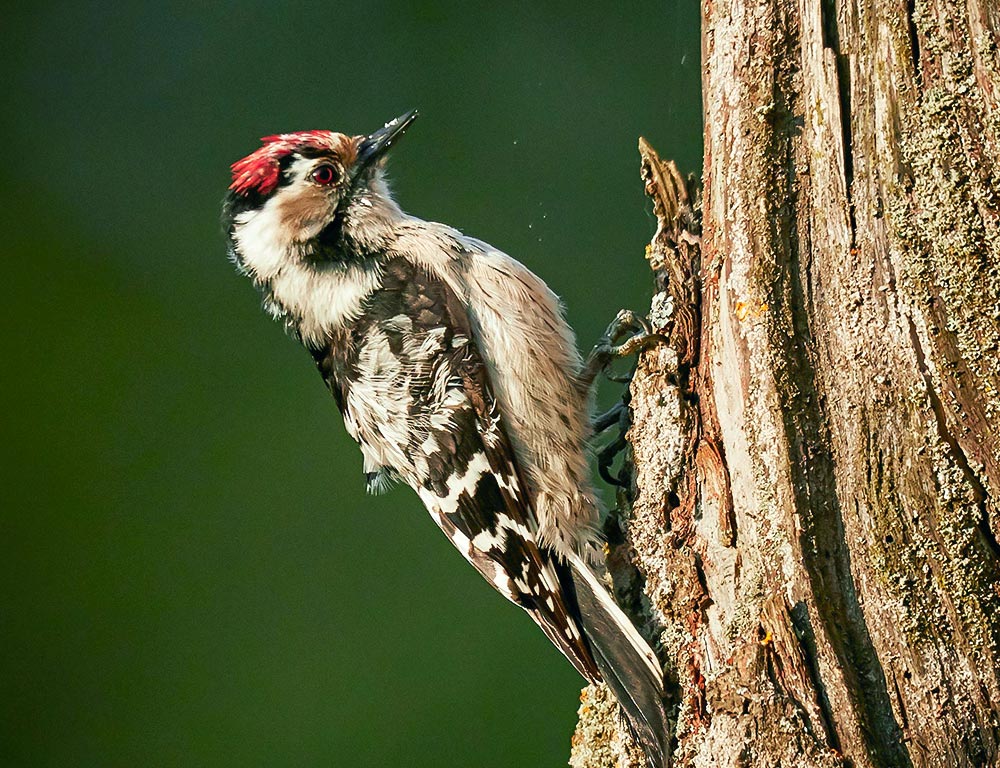
- Scientific name: Dryobates pubescens
- Size: 5.5 to 7.1 inches
- Weight: 0.7 to 1.0 ounces
- Food: Insects, seeds, berries
- Population: Common and widespread
- Life span: Up to 6 years
- Wingspan: 9.8 to 11.8 inches
- Status: Least Concern
The Downy Woodpecker is the smallest woodpecker in North America, recognized by its black and white plumage and small size.
These birds are highly adaptable and can be found in various habitats, from forests to urban areas.
Downy Woodpeckers are skilled climbers, foraging on tree trunks and branches for insects and larvae. They are commonly observed in backyard feeders, where they consume suet and seeds.
With a stable and widespread population, Downy Woodpeckers are considered a species of least concern, showcasing their ability to thrive in diverse environments.
4. Red-bellied Woodpecker
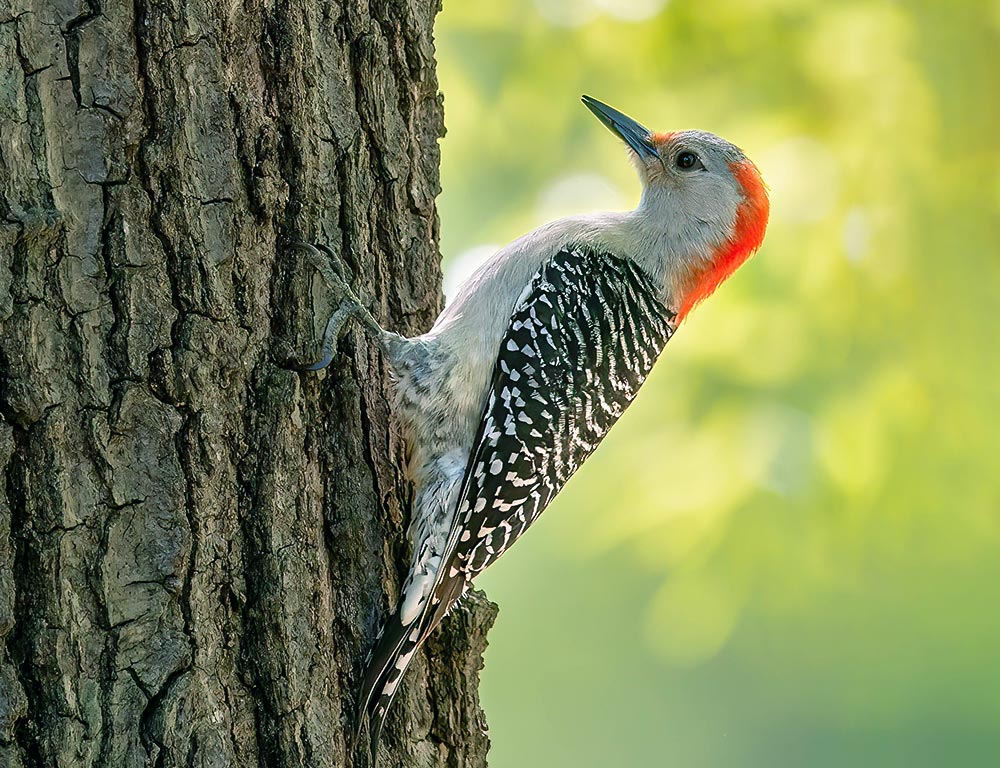
- Scientific name: Melanerpes carolinus
- Size: 9 to 10.5 inches
- Weight: 2 to 3.2 ounces
- Food: Insects, fruits, seeds, and occasionally small vertebrates
- Population: Common and widespread
- Life span: Up to 9 years
- Wingspan: 13 to 16 inches
- Status: Least Concern
The Red-bellied Woodpecker is named for its slightly reddish belly, which may not always be visible. This species has a distinctive zebra-like pattern on its back and a red cap on its head.
Red-bellied Woodpeckers are adaptable birds, thriving in various habitats, from woodlands to urban areas.
They use their strong bills to drill into trees in search of insects and also consume fruits and seeds.
These woodpeckers are known for their vocalizations and can often be heard drumming on trees to communicate with other species members.
5. Yellow-bellied Sapsucker
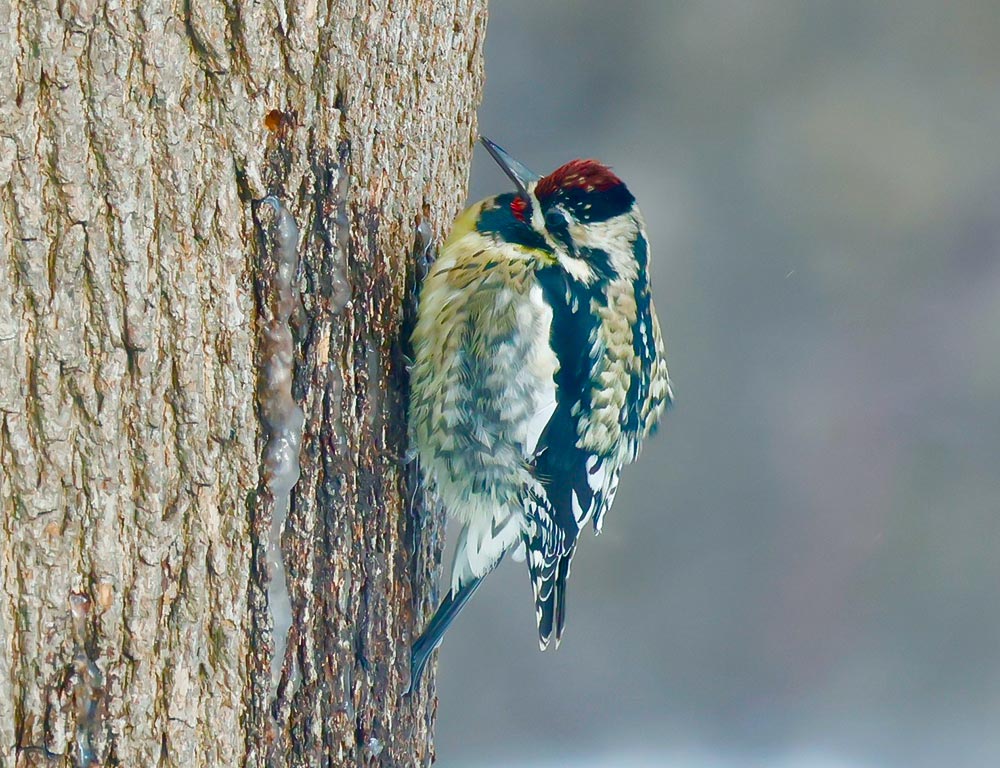
- Scientific name: Sphyrapicus varius
- Size: 7.1 to 8.7 inches
- Weight: 1.5 to 1.9 ounces
- Food: Sap, insects, fruits
- Population: Stable
- Life span: Up to 9 years
- Wingspan: 13 to 16 inches
- Status: Least Concern
The Yellow-bellied Sapsucker is a migratory woodpecker with unique feeding behaviour.
Unlike other woodpeckers, it drills shallow holes in trees to feed on sap. These sapsucker wells also attract insects, providing an additional food source.
Found in deciduous and mixed forests, Yellow-bellied Sapsuckers have a distinctive black and white plumage with a red forehead and throat.
Despite their peculiar feeding habits, their populations are stable and play a role in creating habitat diversity within forests.
6. Northern Flicker
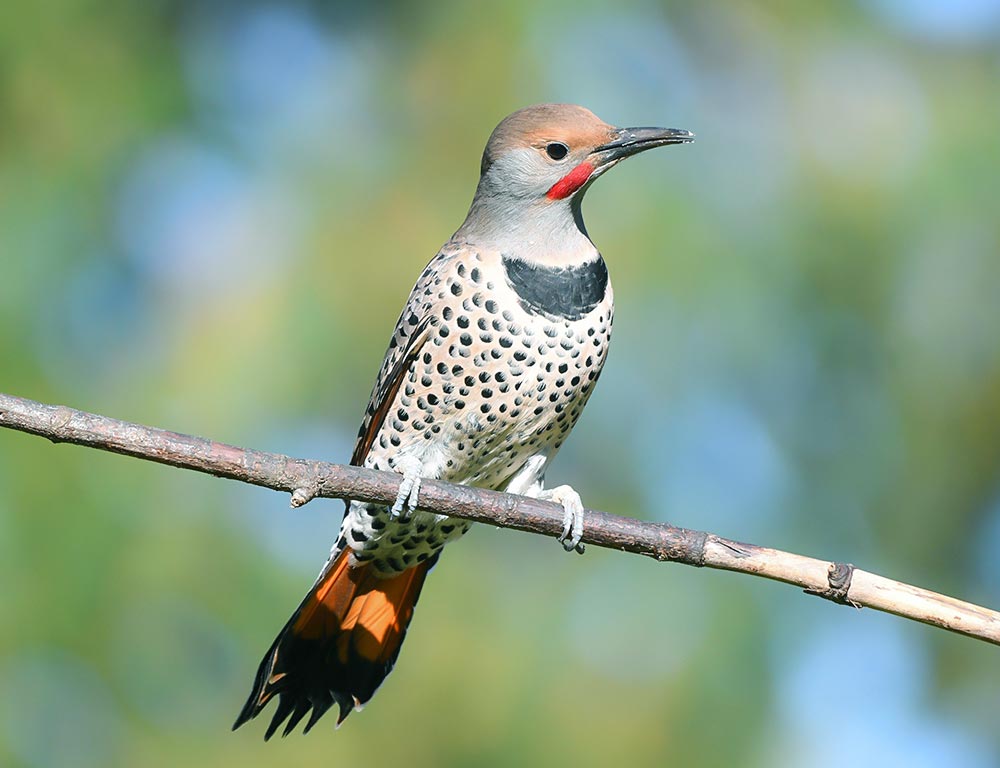
- Scientific name: Colaptes auratus
- Size: 11 to 14 inches
- Weight: 3.9 to 5.6 ounces
- Food: Insects, fruits, seeds, and ants
- Population: Common and widespread
- Life span: Up to 9 years
- Wingspan: 17 to 21 inches
- Status: Least Concern
The Northern Flicker is a medium-sized woodpecker with distinctive spotted plumage. They have a unique feeding behaviour, often foraging on the ground for ants and beetles.
Northern Flickers are adaptable and can be found in various habitats, including woodlands, open areas, and urban environments.
These woodpeckers are known for their “flicker” calls and drumming sounds. With a broad distribution and a stable population, Northern Flickers are considered a species of least concern.
7. Red-cockaded Woodpecker
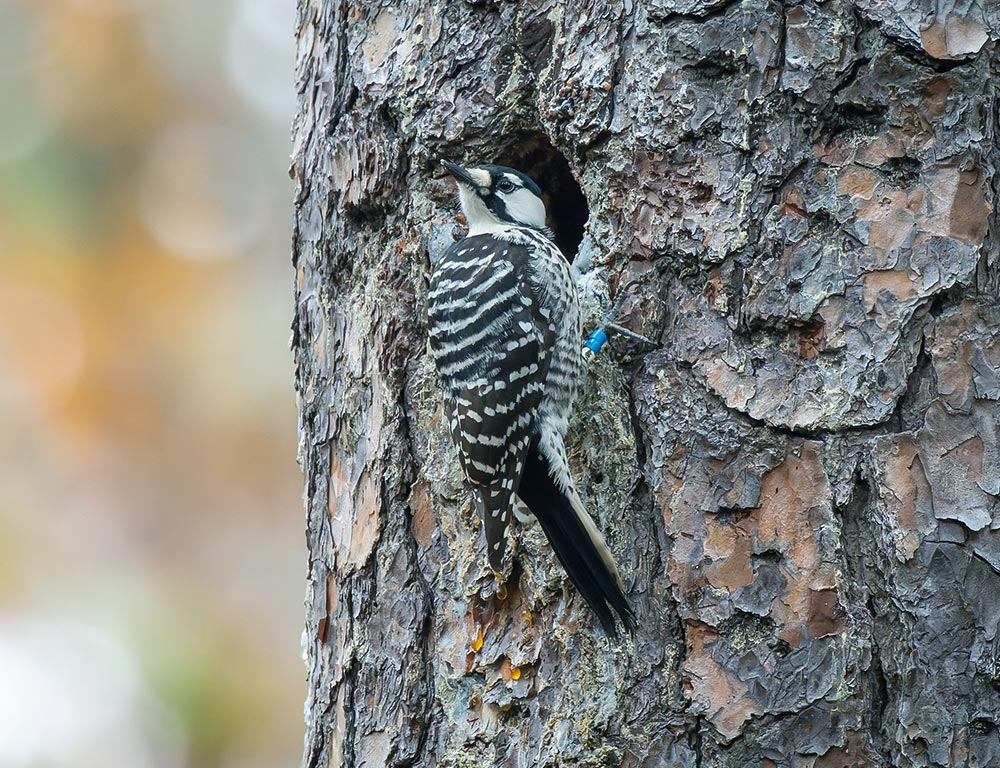
- Scientific name: Leuconotopicus borealis
- Size: 7 to 9 inches
- Weight: 1.6 to 2.2 ounces
- Food: Insects, spiders
- Population: Endangered, with recovery efforts ongoing
- Life span: Up to 8 years
- Wingspan: 13 to 16 inches
- Status: Endangered
The Red-cockaded Woodpecker is a small, black-and-white woodpecker with a distinctive black cap and a small red streak, or “cockade,” behind the eye. This species highly depends on mature pine forests, particularly the longleaf pine ecosystem.
Due to habitat loss and changes in forestry practices, the Red-cockaded Woodpecker has become endangered.
Conservation efforts, including habitat restoration and artificial cavity installations, are being implemented to help recover and stabilize their populations.
These woodpeckers play a crucial role in maintaining the health of their unique pine forest habitats.
8. Golden-fronted Woodpecker
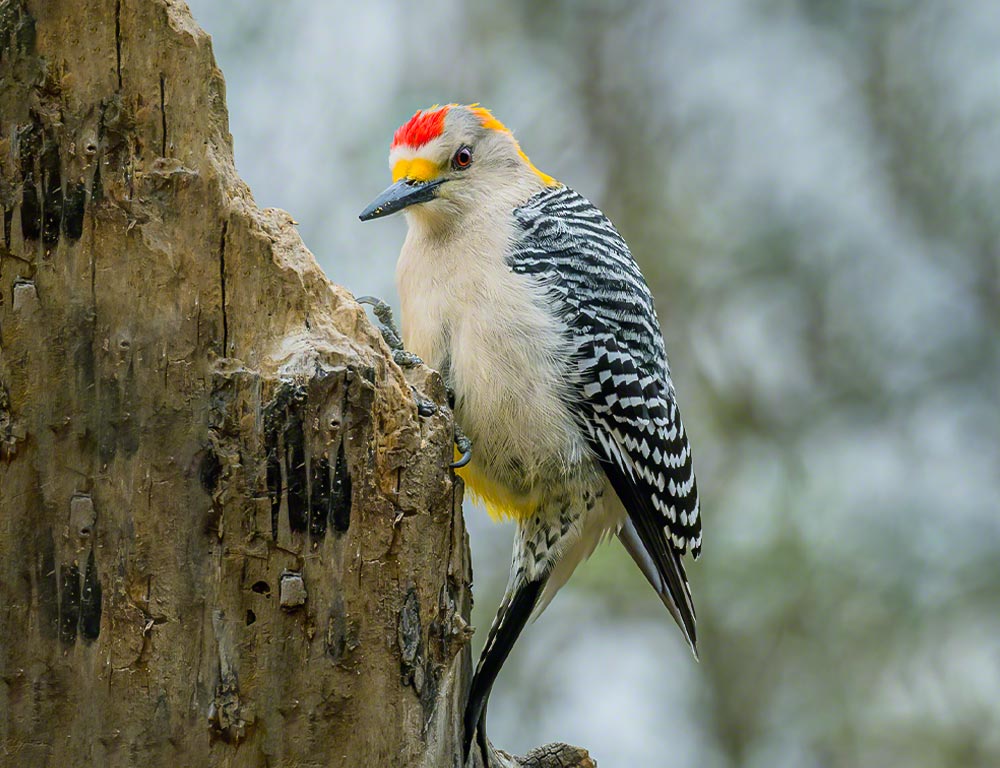
- Scientific name: Melanerpes aurifrons
- Size: 8.3 to 10.2 inches
- Weight: 2.3 to 3.2 ounces
- Food: Insects, fruits, seeds, and occasionally small reptiles
- Population: Common and widespread in the southwestern United States and Mexico
- Life span: Up to 9 years
- Wingspan: 13 to 16 inches
- Status: Least Concern
The Golden-fronted Woodpecker is named for its golden-yellow nape and forehead. With a striking appearance, they have a mix of black, white, and red on their bodies.
These woodpeckers are found in various habitats, including woodlands, scrublands, and urban areas. Their diet consists of insects, fruits, and seeds, and they are known for their strong, rapid drumming on trees.
Golden-fronted Woodpeckers are adaptable and have successfully colonized various environments, contributing to their status as a species of least concern.
9. Dryocopus
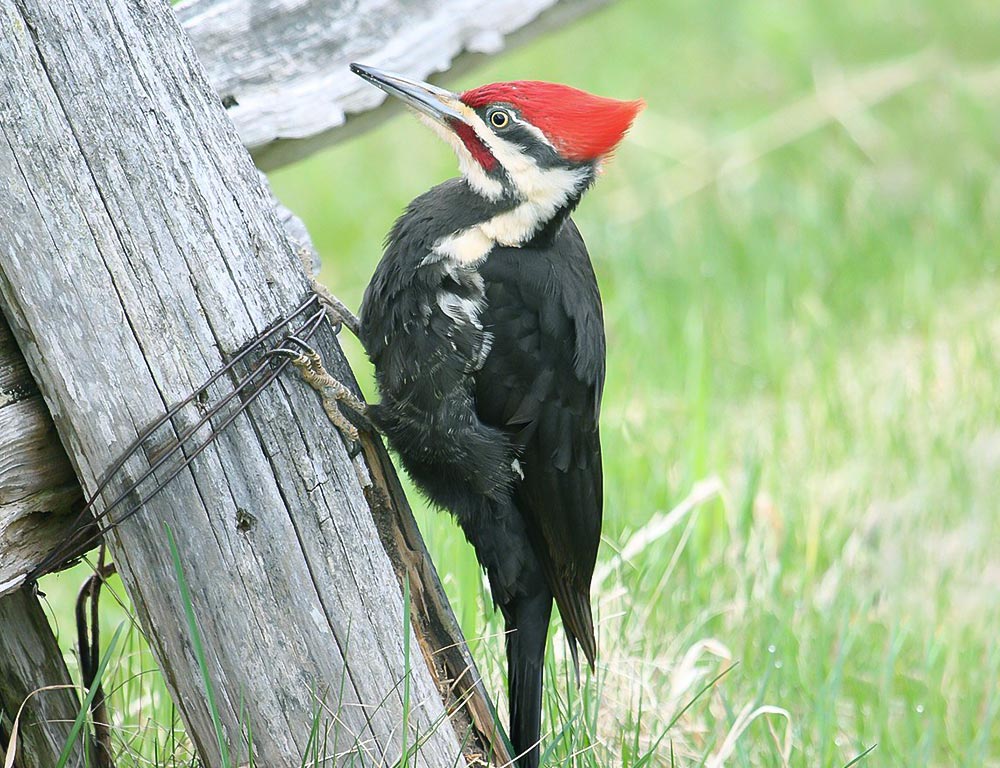
Dryocopus is a genus of woodpeckers that includes several species, such as the Black Woodpecker (Dryocopus martius).
- Size: Varies by species; Black Woodpecker is around 15 to 18 inches
- Weight: Varies by species
- Food: Insects, larvae, and occasionally small vertebrates
- Population: Varies by species
- Life span: Varies by species
- Wingspan: Varies by species
- Status: Varies by species
The genus Dryocopus encompasses larger woodpeckers, and they often have entirely black or dark plumage. The Black Woodpecker, for example, is known for its large size and powerful drumming.
These woodpeckers typically inhabit mature forests and play a crucial role in ecosystem dynamics by controlling insect populations.
10. Ivory-billed Woodpecker
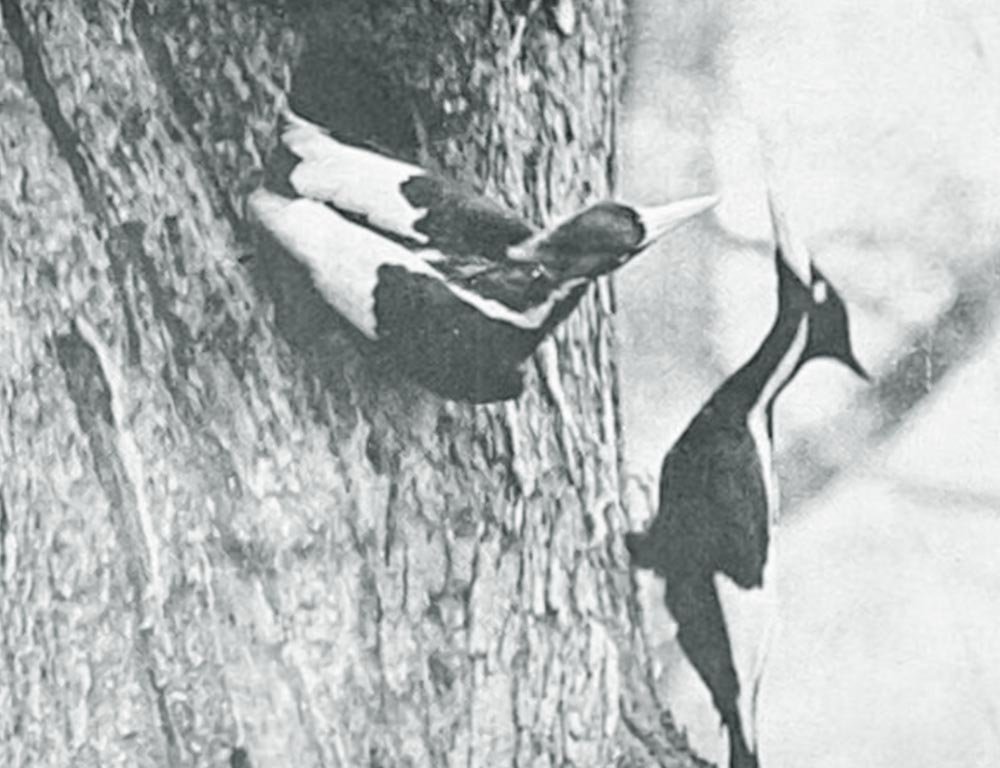
- Scientific name: Campephilus principalis
- Size: 19 to 20 inches
- Weight: 1.1 to 1.6 pounds
- Food: Insects, especially beetle larvae
- Population: Critically endangered or possibly extinct
- Life span: Unknown
- Wingspan: 30 to 31 inches
- Status: Critically Endangered (Possibly Extinct)
The Ivory-billed Woodpecker is one of the largest woodpeckers in the world and is known for its distinctive ivory-coloured bill.
Once widespread in the southeastern United States, this species is now considered critically endangered, with some experts believing it may be extinct. The primary threats include habitat loss and logging.
Efforts have been made to search for potential remaining populations, but definitive evidence has been elusive.
The status of the Ivory-billed Woodpecker highlights the importance of conservation measures to protect and preserve the habitats of endangered species.
11. Melanerpine Woodpeckers
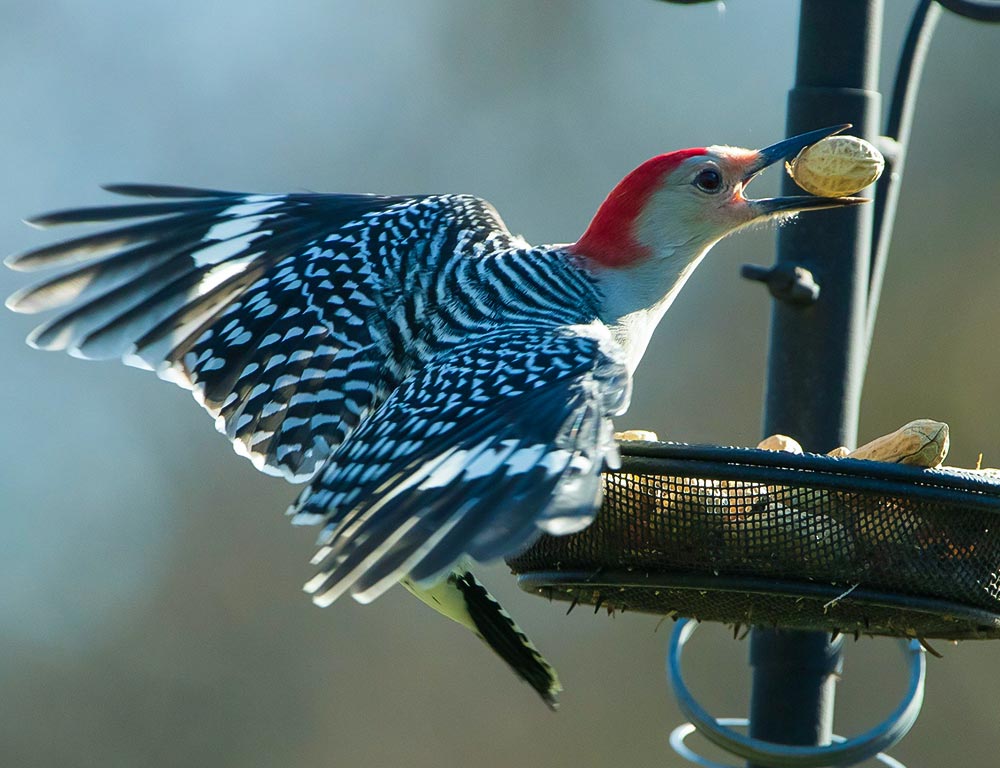
Melanerpine woodpeckers refer to woodpeckers within the subfamily Melanerpinae.
- Size: Varies by species (includes Red-headed Woodpecker, Lewis’s Woodpecker, and others)
- Weight: Varies by species
- Food: Insects, fruits, seeds
- Population: Varies by species
- Life span: Varies by species
- Wingspan: Varies by species
- Status: Varies by species
Melanerpine woodpeckers encompass a diverse group with different species exhibiting various sizes, colors, and habits. The Red-headed Woodpecker mentioned earlier belongs to this subfamily.
While some, like the Red-headed Woodpecker, may face population declines, others may be more common and widespread.
Conservation efforts may target specific species within this subfamily based on their individual status and needs.
12. Red-naped Sapsucker
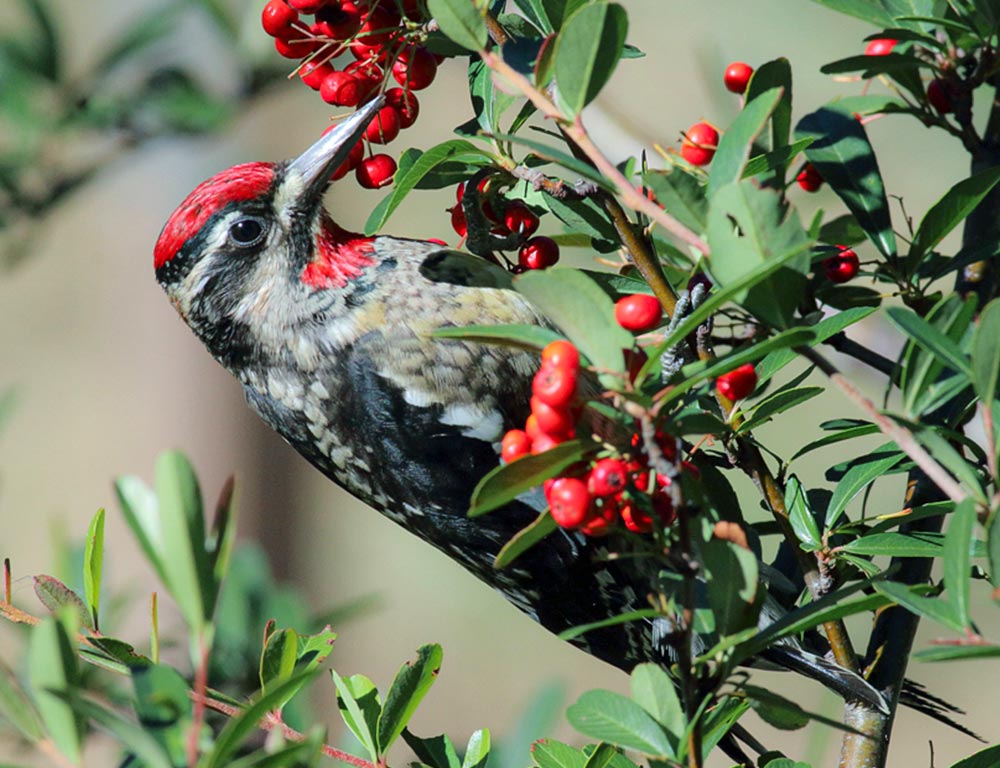
- Scientific name: Sphyrapicus nuchalis
- Size: 7.1 to 8.7 inches
- Weight: 1.5 to 2.1 ounces
- Food: Sap, insects, fruits
- Population: Stable
- Life span: Up to 9 years
- Wingspan: 13 to 16 inches
- Status: Least Concern
The Red-naped Sapsucker is a medium-sized woodpecker with a distinctive red patch on the nape of its neck. These birds are primarily found in western North America, preferring coniferous and mixed woodlands.
They play a unique role in ecosystems by creating sap wells on trees, attracting insects, and providing food for other species.
Despite their specialized feeding habits, Red-naped Sapsucker populations are stable and considered a species of least concern.
13. Lewis’s Woodpecker
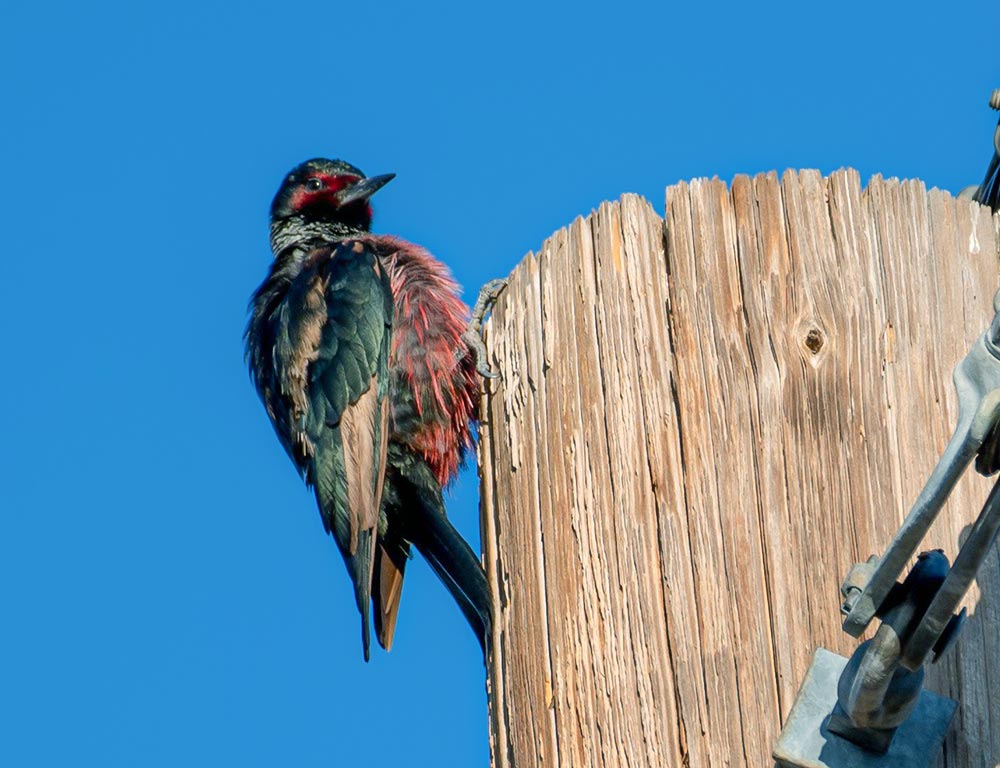
- Scientific name: Melanerpes lewis
- Size: 10 to 11 inches
- Weight: 3.2 to 4.2 ounces
- Food: Insects, fruits, nuts
- Population: Decreasing, considered a species of concern
- Life span: Up to 8 years
- Wingspan: 18 to 20 inches
- Status: Near Threatened
Lewis’s Woodpecker is known for its unique appearance, featuring a dark greenish-black plumage with a pinkish-red belly.
Unlike many woodpeckers, Lewis’s Woodpeckers catch insects on the wing and also feed on fruits and nuts. They prefer open woodlands, especially those affected by fire.
Unfortunately, their populations have been decreasing due to habitat loss and changes in fire management practices. Conservation efforts are underway to address these challenges and ensure the survival of Lewis’s Woodpecker.
14. Williamson’s Sapsucker
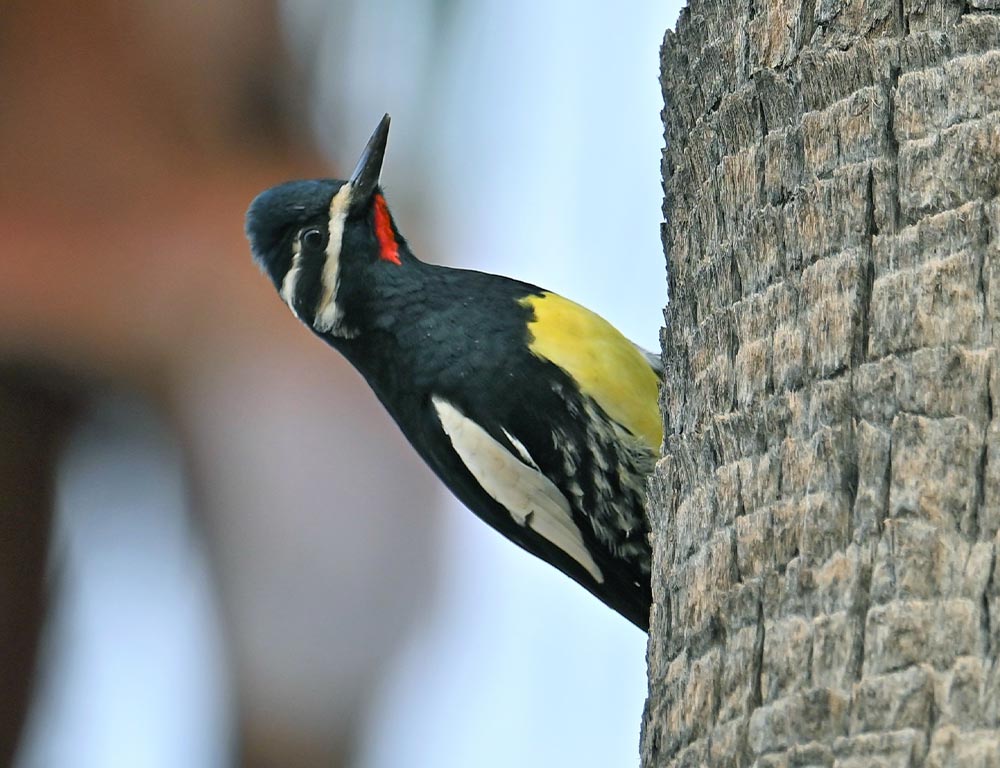
- Scientific name: Sphyrapicus thyroideus
- Size: 8.3 to 9.8 inches
- Weight: 1.6 to 2.5 ounces
- Food: Sap, insects
- Population: Stable
- Life span: Up to 9 years
- Wingspan: 16 to 18 inches
- Status: Least Concern
Williamson’s Sapsucker is a medium-sized woodpecker with distinctive black and white plumage, including a yellow belly on males.
They are primarily found in western North America, favouring coniferous forests. Like other sapsuckers, they create sap wells on trees to feed on sap and attract insects.
With stable populations and relatively wide distribution, Williamson’s Sapsucker is considered a species of least concern.
15. Red-breasted Sapsucker
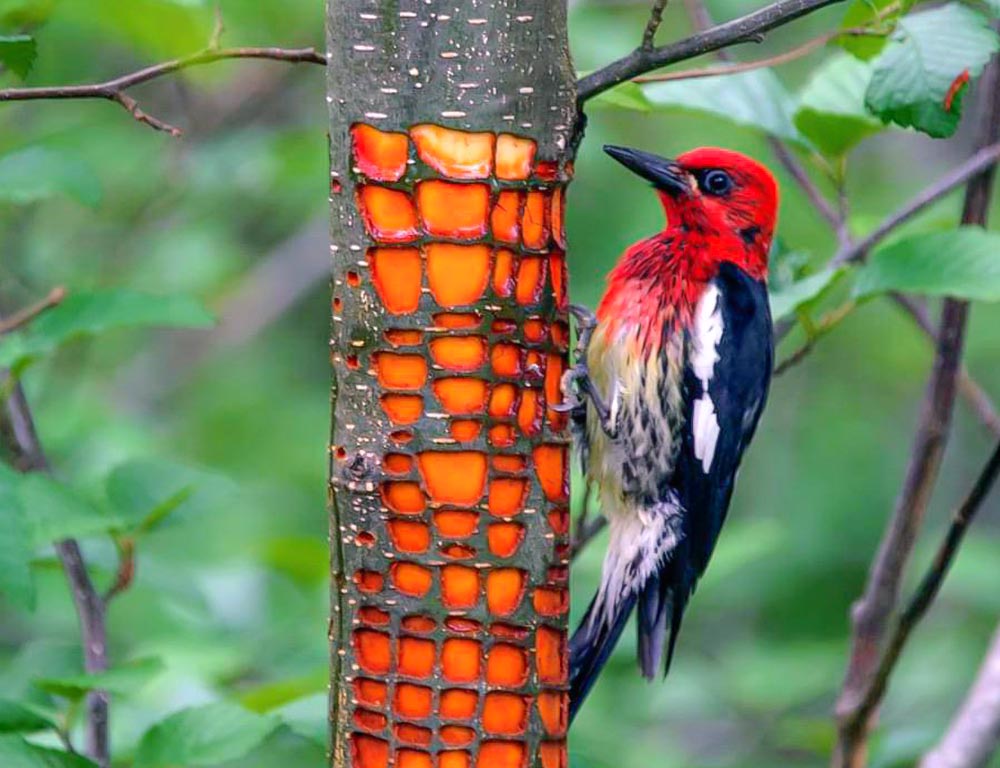
- Scientific name: Sphyrapicus ruber
- Size: 8.3 to 9.8 inches
- Weight: 1.7 to 2.5 ounces
- Food: Sap, insects, fruits
- Population: Stable
- Life span: Up to 9 years
- Wingspan: 14 to 16 inches
- Status: Least Concern
The Red-breasted Sapsucker is characterized by its red head and throat, distinguishing it from other sapsuckers.
In western North America, these woodpeckers create sap wells on trees and feed on insects and fruits.
With stable populations and a broad range of habitats, the Red-breasted Sapsucker is considered a species of least concern.
16. Nuttall’s Woodpecker
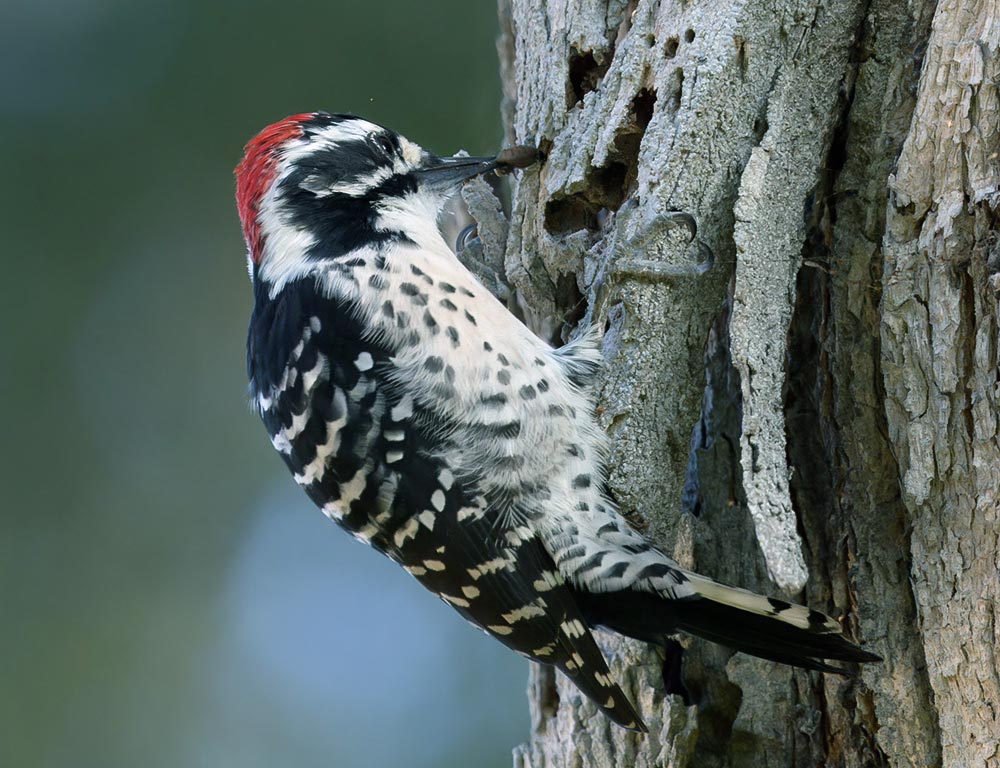
- Scientific name: Dryobates nuttallii
- Size: 6.3 to 7.5 inches
- Weight: 1.2 to 1.8 ounces
- Food: Insects, spiders, ants, seeds, and berries
- Population: Common and widespread in western North America
- Life span: Up to 8 years
- Wingspan: 12 to 13 inches
- Status: Least Concern
Nuttall’s Woodpecker is a small to medium-sized woodpecker found in western North America. It is known for its striking black and white striped back and ladder-like pattern on its face.
These woodpeckers inhabit various environments, including oak woodlands, riparian areas, and suburban regions.
Nuttall’s Woodpeckers feed on insects, spiders, ants, seeds, and berries. They use their strong bills to excavate cavities in trees for nesting and foraging.
These woodpeckers are known for their drumming sounds, which play a role in communicating with others.
As a species of least concern, Nuttall’s Woodpecker benefits from its adaptability to different habitats and its ability to thrive in both natural and human-altered landscapes.
Wrapping Up
The woodpeckers of Texas showcase a captivating array of species, from the resilient Red-headed to the majestic Pileated.
These birds play vital roles in their ecosystems, embodying adaptability and contributing to the rich biodiversity of Texas.
Despite challenges faced by certain species like the endangered Red-cockaded Woodpecker, ongoing conservation efforts underscore the importance of preserving their habitats for future generations. Thank you so much.